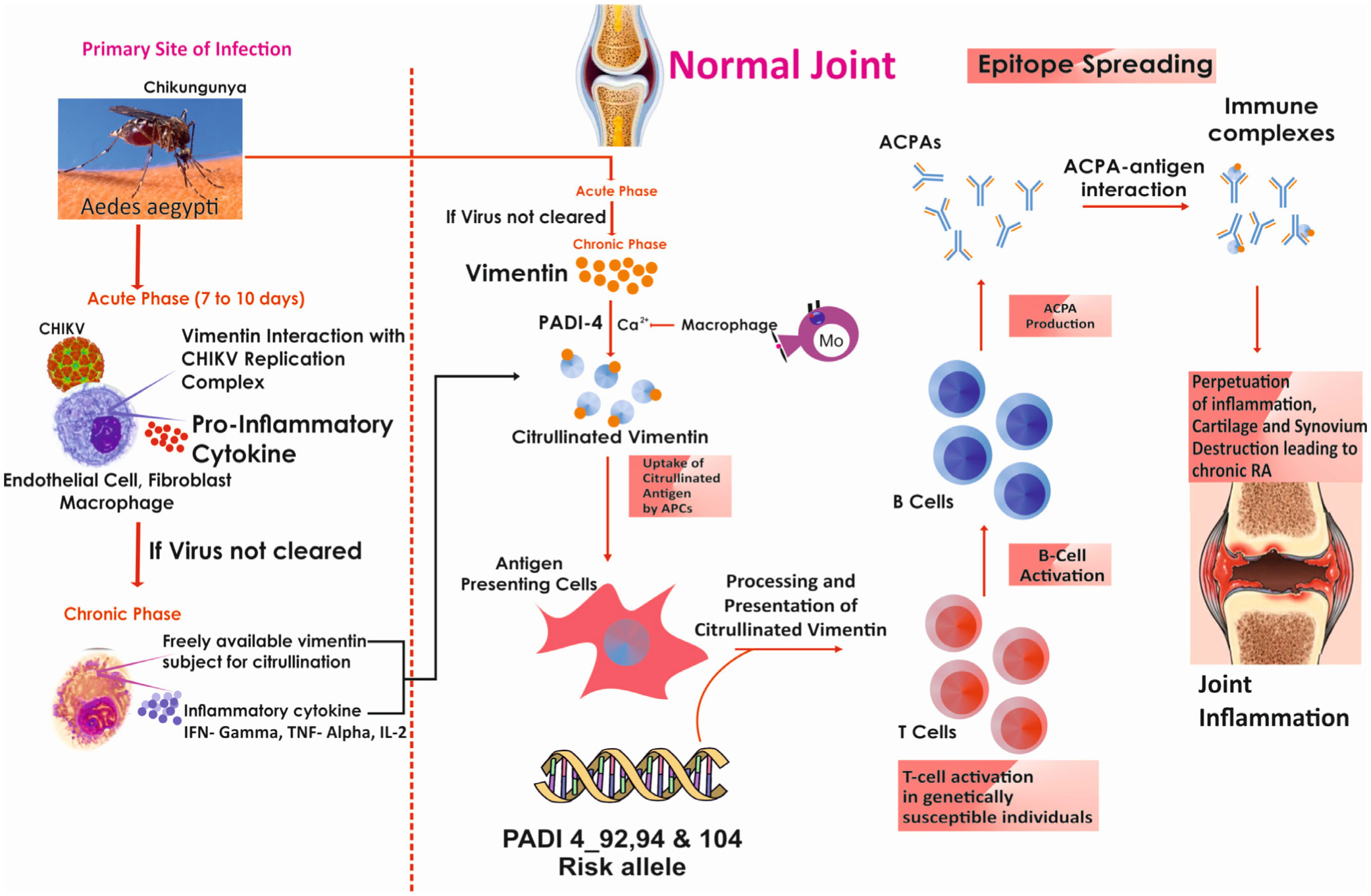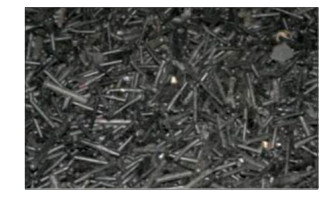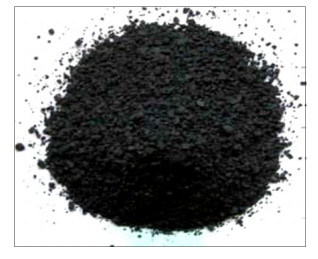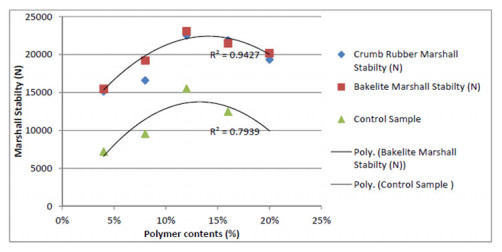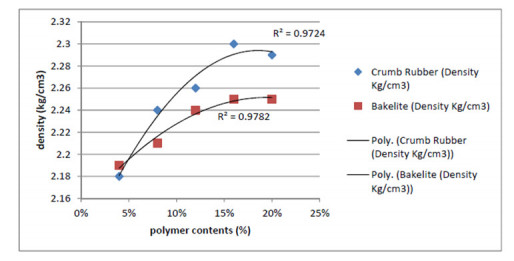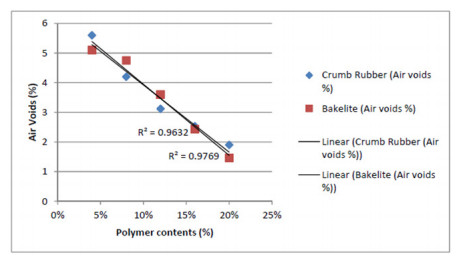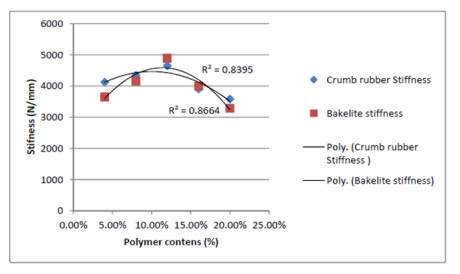Construction is always a complex in the nature and especially flexible road pavement which is the most prerequisites for the smooth transportation. The country economic growth is linked with smooth and fast transportation network where major transportation carried through road network interconnected cities and now major countries. Durable road pavement structure is an essential but pavement infrastructure is more vulnerable to the several failures among rutting and permanent deformation is the most common. Trial based studies encouraged to reuse waste polymers which may enhance the asphalt pavement. Study has chosen waste crumb rubber and Bakelite to study themechanical properties by addition ratio of 4.0%, 8.0%, 12.0%, 16.0% and 20.0%. Bitumen penetration grade 60/70 and ACW-20 were selected after examine the bitumen and aggregate tests Marshall mixture were designed and tested for density, Marshall stability, flow, air voids and stiffness properties for the control, crumb rubber and Bakelite samples. The encouraging result shows that addition of crumb rubber and Bakelite by 12% significantly improve the properties of asphalt mixture almost double Marshall stability strength compare to the control sample, higher density, control flow within the recommended range and higher stiffness shows strong resistance against rutting and permanent deformation. Study concluded crumb rubber and Bakelite has potential to enhance the mechanical properties and between them Bakelite shows better result in term of higher strength and stiffness.
1.
Introduction
Rheumatoid arthritis (RA) is a chronic systemic autoimmune inflammatory disease categorized by joint swelling and tenderness leading to destruction of cartilage and bone, resulting in severe physical disability and premature mortality [1],[2]. It holds 42nd position in causing physical disability around the World with a stable rise from 3.3 to 4.8 million in a span of 20 years. Globally, the prevalence of RA is believed to range from 0.5% to 1% [3].
Although RA etiology is not fully elucidated, the multifactorial nature reflects “Bermuda triangle” of genetic, environment and autoimmunity robustly persuading the onset and persistence of pathologic condition [4]. Numerous studies have publicized that environmental factors play a substantial role in the development of RA in an appropriate genetic background [5]. FHRA, cigarette smoking, CHIKV, periodontitis [6] and physical trauma [7] has been assumed to be a promising risk factor for RA. Moreover, the recognition of a “preclinical” phase of RA via the evaluation of autoantibodies and other biomarkers proposes that the triggering agents for RA are performing long before the initial clinical indication of inflammatory arthritis.
All these highlight the instigation of new era, which will possibly unravel the complex interplay between gene and environmental factors, and also specific pathologically linked immune reactions that may be initiated in the background of diverse gene to environment combinations. Further, probing of individual risk factors and whether they control specific citrullination between the exposed and non-exposed may provide deeper understanding, which will assist in designing target-oriented drug and modelling of the risk prediction. To this end, consistent result from ethnically diverse population is required, because risk factors recognized in one ethnic population is not replicated in another.
Till date, human leukocyte antigen-DR isotype (HLA-DRB1) gene and smoking has been proved beyond doubt as a RA threat [8], however, other potential targets remain to be elucidated. Convincing case-control study in the context of RA triggering factors such as FHRA, CHIKV, physical trauma/surgery, tooth decay and diet pattern were undertaken. Strikingly, till date, the impact of these triggers on inflammatory mediated citrullination of vimentin and α-enolase is unexplored in the Indian population.
In order for an environmental agent to be established as a disease, biochemical, and immunological event followed by a trigger should act in favour of disease pathology in genetically susceptible individuals. When susceptible loci interact with prospective risk variables, the chances of pathologic signature are higher and more vulnerable. Symptom similarities between RA and CHIKV arthritis was intriguing to investigate whether the immunologic events and genetic susceptibility of RA could also be a mediator of CHIKV induced RA and also whether probable mechanism that remains obscure be elucidated by connecting all the related events.
2.
Materials and methods
Blood samples were collected from South Indian Tamil RA patients visiting a Rheumatology clinic in Chennai, Tamil Nadu, India during 2014 to 2018. Patients presenting with at least 1 joint with definite clinical synovitis or synovitis not clearly explained were subjected to further screening. Details of age, sex, symptoms and duration of disease were obtained and also examined the number of swollen and tender joints. Patients with existing diagnosis of osteoarthritis, and other rheumatic diseases were excluded. We studied 207 South Indian Tamil RA cases satisfying the revised 2010 American College of Rheumatology criteria for the classification of RA. Age and sex matched 186 South Indian Tamil healthy individuals without any other rheumatic diseases were enrolled as healthy control group. To identify the etiologic factors, prepared a well-designed questionnaire incorporating potential risk factors and details obtained from RA cases and healthy controls with their informed consent prior to enrolment into the protocol. Past exposure of CHIKV infection ascertained from their medical records.
2.1. Blood sample collection
Venous blood was collected by standard protocol into redtop vacutainer for serological parameters, blacktop (citrate) for ESR, purple top (ethylene diamine tetra acetic acid (EDTA)) for genetic analysis. Serum and whole blood was stored at −70 °C.
2.2. Calculation of disease activity score (DAS)-28
DAS-28 was calculated based on the number of swollen joint count, tender joint count and ESR using online DAS-28 calculator (https://www.rheumakit.com/en/calculators/das28). A DAS-28 of less than 3.2 implies low disease activity, 3.2–5.1 moderate disease activity and more than 5.1 active disease.
2.3. Laboratory parameters
2.3.1. Rheumatoid factor (RF)
RF was assayed by Immunoturbidimetry. Values >14 IU/mL were considered positive. Samples above the linearity limit of 130 IU/mL were diluted to get the absolute value.
2.3.2. C-reactive protein (CRP)
CRP was performed by particle enhanced Immunoturbidimetry. CRP of <5.0 mg/L was considered negative and >5.0 mg/L as positive. Samples above the linearity limit of 250 mg/L were diluted to get the exact value.
2.3.3. Anti-cyclic citrullinated peptide (CCP)
Anti-CCP was performed by second generation kit which uses multiple citrullinated peptide by Electrochemiluminesence Immuno Assay (ECLIA). Values >17 U/mL were considered positive. All samples above the linearity limit of 500 U/mL were taken as 501 U/mL.
Bio-Rad Liquicheck Immunology quality control (RF & CRP) and Roche Preci control (anti-CCP) was run daily. IgM RF, CRP and anti-CCP were performed as per the respective pack insert of the manufacturer on automated Roche COBAS 6000 equipment.
2.3.4. Anti-Sa and anti-CEP-1 antibodies
Anti-Sa and anti-CEP-1 antibody were quantified using an enzyme-linked immunosorbent assay (ELISA) (EUROIMMUN) according to the manufacturer's instructions. Values less than 20 RU/mL were considered negative and more than 20 RU/ml positive. Results above 200 RU/mL were diluted to obtain absolute value.
2.3.5. Erythrocyte sedimentation rate (ESR)
ESR was measured by Westergren's method. Reference interval is 5–15 mm/h for male and 5–20 mm/h for female.
2.4. Statistical analysis
Nominal variables were expressed as frequencies and continuous variables distributed normally were expressed as mean ± standard deviation. Mann–Whitney U-test were used to evaluate the differences between two groups. Odds ratio (OR) and 95% confidence intervals (CI) of cases and controls were examined using bivariate analysis and chi-square test. The Hardy–Weinberg equilibrium (HWE) for the single nucleotide polymorphisms (SNP) was calculated with the chi-square test. Genotype frequency of studied polymorphism between cases and controls were analyzed using an online SNPSTATS program (https://www.snpstats.net/snpstats/analyser.php). Statistical analysis was performed using Statistical Package for the Social Sciences (SPSS) version 20.0. p-value < 0.05 was considered as statistically significant.
2.5. Ethics approval of research
The study was approved by Institutional Human Ethics Committee (IHEC), HDC/IHEC/002, Hitech Diagnostic Centre, Chennai.
3.
Results
3.1. Assessment of serological and etiological factors in RA cases and healthy controls of South Indian Tamil population
Table 1 summarizes serological and etiological characteristic of 207 South Indian Tamil RA cases and 186 South Indian Tamil healthy controls. Two groups restrain similar ratio of gender, cases enclosed 178 (86.0%) females and 29 (14.0%) males whereas controls constituted 161 (86.6%) females and 25 (13.4%) males. At the time of enrolment, RA had travelled 6.7 ± 4.3 years with moderate disability index (4.5 ± 0.6). Frequency of analysed antibody positivity among RA cases were RF (88.9%), anti-CCP (85.5%), anti-Sa (61.8%) and anti-CEP-1 (68.6%) with mean value of RF (162.7 ± 235.8), anti-CCP (293.8 ± 195.3), anti-Sa (94.9 ± 129.4), anti-CEP-1(77.8 ± 82.4),CRP (19.7 ± 33.9) and ESR (54.7 ± 28.6). In controls, studied serological and inflammatory markers were within the respective reference interval.
Genetic and environment factors that are promising trigger for RA initiation were analysed. Among 26.1% of RA cases FHRA was associated with high RA risk (p = 0.001) to controls.72.2% of RA cases disclosed RA affected first degree relatives (FDRs) and 27.8% non-FDRs.
When analysing RA triggers, 41.1% cases who reported surgery/injury were significantly linked with risk (p = 0.001) to 21.5% controls. Among surgery/injury experienced RA cases 62.4% had underwent cesarean. Overall 67.1% had RA onset within a year of exposure to surgery/injury especially cesarean delivery (62.4%) to be a potential etiologic threat for RA.
In addition, 45.9% RA cases affected with CHIKV had marked association with RA risk compared with 11.3% controls affected with CHIKV (p = 0.001). Shockingly, among 95 CHIKV exposed RA cases, 76 (80%) of cases have developed RA within a year of infection.
Smoking vigorously influenced RA risk among 55.2% of male cases to controls (p = 0.010). Both tooth decay history and diet pattern did not demonstrate RA risk among the South Indian Tamil RA cases.
3.2. Comparison of serological parameters between with and without surgery in Tamil RA cases
Analysis performed to recognize whether assessed risk factors have worsening effect on pathological process of citrullination and inflammation in Tamil RA cases. As summarized in Table 2, cases with surgery/injury did not document marked variation in concentration and frequency of studied serological and inflammatory markers (p > 0.05).
3.3. Comparison of serological parameters between with and without CHIKV in South Indian Tamil RA cases
Table 3 depicts 95 CHIKV infected RA cases had remarkably higher level of anti-Sa (p = 0.048) and ESR (p = 0.018) compared with 112 non-CHIKV infected RA cases and no disparity in the level of anti-CCP, anti-CEP-1, CRP and DAS-28 (p > 0.05).
Probably, CHIKV persuaded RA through vimentin citrullination which is evidenced by increased anti-Sa frequency also (p = 0.018). The other antibodies failed to show any key variation (p > 0.05).
3.4. Comparison of serological parameters between with and without tooth decay history in South Indian Tamil RA cases
Table 4 illustrates 143 cases reported with preceding history of tooth decay had significantly elevated level of anti-CEP-1 (p = 0.015) and inflammatory markers (p < 0.05) compared to 64 cases with no history of tooth decay. While RF, anti-CCP and anti-Sa level were insignificant (p > 0.05), Tamil RA cases with tooth decay showed a remarkably higher frequency of RF (p = 0.023), anti-CCP (p = 0.047), anti-Sa (p = 0.008) and anti-CEP-1 (p = 0.026) to those without tooth decay.
Smoking did not influence the serology and inflammatory markers in Tamil RA cases as in Table 5.
3.5. PADI4 genotype and allelic frequencies in CHIKV infected RA cases and healthy controls
As represented in Table 6, CHIKV to PADI4 interaction demonstrated CHIKV infected RA cases have significantly higher proportion of susceptible C allele compared to CHIKV infected controls (PADI4_92; p = 0.04, PADI4_104; p = 0.02, PADI4_94; p = 0.02) highlighting “C” as the risk allele playing a central role in CHIKV induced RA.
Considering genotype frequency, PADI4_92 (OR = 2.44, 95% CI 0.87–6.84; p = 0.08) and PADI4_104 (OR = 2.34, 95% CI 0.87–6.27; p = 0.08) had trend towards risk for RA as suggested by odds ratio. Nevertheless, genotype of PADI4_94 had no remarkable variation (p = 0.50).
4.
Discussion
Genomic and pharmacological research in RA clinical areas have shown attractive difference between ethnic groups in disease phenotype, gene to environment interaction and drug efficiency, underscoring the need of specific ethnic studies to gain insights into the linkage between risk factors and RA phenotype. Therefore, the present investigation was undertaken to identify potential risk factors that may drive citrullination mediated antibody generation and assess their interaction with PADI4 loci in South Indian Tamil RA population.
DAS-28 and HAQ were moderately presented in this population, describing both are intertwining in RA pathogenesis. Equivalent pattern documented in previous findings [9],[10]. Current South Indian Tamil RA population travelled 6.7 years with RA is well correlated with other studies [11]. Frequency of RF, anti-CCP, anti-Sa and anti-CEP-1 were 88.9%, 85.5%, 61.8% and 68.6% respectively. This outcome is supported by previous publications which documented the incidence of RF [12], anti-CCP [12],[13], anti-Sa [14] and anti-CEP-1 [12],[15],[16].
RA risk increases 1.5 to 3 fold for children of RA women during their lifetime [17], emphasizing the inevitable role of heredity in RA etiology. Present work displayed 10 fold higher risk of RA in patients with FHRA (26.1%). Of them, FDRs constituted 72.2% and non-FDRs comprised 27.8% are almost similar proportion to North Kerala study [6]. FHRA increases the risk of RA, especially those with FDRs had severe diseases activity [18].
It has been acknowledged that noticeable signs of inflammation materialized in synovial joints after few months of physical trauma/injury/fracture [19],[20], nonetheless, the commencement of synovial inflammation after surgery in normal healthy individuals is still uncertain. In this study, preceding history of surgery/injury (41.1%) was statistically prominent to controls. Alarmingly, of them, 67.1% registered RA onset within one year of the incidence. The possible mechanism include ischemic reperfusion, either localized or systemic hypoxia from tissue injury [21], release and accumulation of mitochondrial constituents and nuclear antigens from dying tissue [22], and the collision of cartilaginous particles into synovial tissue, which then provokes the generation of inflammatory cytokines and proteinases by synovial lining [23]. Strikingly, 62.4% surgery reported RA cases had experienced caesarean surgery, strongly emphasize cesarean was independently connected to RA onset in this population. This could be partly explained by the fact that inflammatory process involved in tissue repair after cesarean surgery at some point, activates citrullination of endogenous vimentin that has high affinity to shared epitope (SE) of HLA-DRB1, succeeded by T-cells recognition [24],[25] with subsequent antibody generation.
CHIKV shares similar clinical characteristics with RA [26] in particular, both have highly identical peripheral T cell phenotypes. [27]. Earlier reports documented persistent rheumatic manifestations with musculoskeletal tissue devastation in CHIKV infected patients [28],[29] and convalescent patients are more likely to experience chronic joint disease because of the immune response to CHIKV [30]. In this study, 45.9% of RA cases reported CHIKV history was remarkably higher than controls, closely resembling previous observations [6],[26]. Strikingly, 80% of them had rapid onset within a year is in line with earlier studies [31]. Possibly, post CHIKV polyarthritis would develop if they failed to eliminate viral RNA, and persistent immune response with increased generation of proinflammatory mediators participate in the proliferation of osteoblast and osteoclast cells [32], generating RA favored autoimmune response in genetically predisposed individuals.
Meta-analysis has claimed 40% higher likelihood of RA among ever smokers than never smokers [33]. The present study investigated its impact on male cases only because none of the female participants were in the habit of smoking, the percentage of RA smokers 55.2% was remarkably higher to controls, suggesting smoking has been implicated in the initiation and propagation of RA. The major pathologic route of smoking persuaded RA is reported to be citrullination in lungs and interaction with HLA-DRB1 genes [34].
Porphyromonas gingivalis (P.gingivalis) causes periodontal disease, affecting connective tissues that support the survival of teeth and gradually leading to tooth loss/tooth decay. Despite 69.1% of Tamil RA cases had tooth decay/tooth loss, significant association not met for RA risk, but OR of 1.25 denotes it might have indirectly involved in etiology via creating pro-pathologic milieu for RA development. This result is in close agreement with earlier report [35]. Contrasting result observed in Korea National Health and Nutrition Examination Survey [36].
Diet pattern showed no influence on RA cases in the current study. While Mediterranean diet score and healthy diet predominantly of vegetarian source were reported to be inversely related to RA risk in large sample size of Epidemiological Investigation of Reumatoid Arthritis (EIRA) and Nurses' Health study (NHS) respectively [37],[38]. The possible protective nature of vegetarian diet could be drawn from experimental model that described suppression of osteoclastogenesis by downregulating tumour necrosis factor (TNF)-α, nitric oxide synthase and interleukin (IL)-6 [39].
It is essential to look at the connection between the individual risk factors and how well they interact with inflammatory mediated autoimmunity or whether they have impact on antibody level and specific citrullination between the exposed and non-expose RA cases. Serological markers of RA cases who underwent surgery were almost similar to those who did not undergo surgery, revealing other factors may be strongly implicated in disease pathogenesis. No statistical significance noticed in smokers relative to non-smokers in this ethnicity probably due to lower number of male cases. An identical pattern documented in previously published South Korean [40] and Swedish population [41].
Although tooth decay did not contribute to RA risk in south Indian Tamil ethnicity an enormous inflammatory and citrullination (vimentin and α-enolase) reaction observed in cases with tooth decay history compared to those without tooth decay among RA cases. Previous studies documented remarkable variation in the concentration of anti-Sa but not anti-CCP and anti-CEP-1 between RA with and without periodontitis subgroups of European descent [42]. The possible explanation of marked inflammation and citrullination observed in cases with tooth decay history could be drawn from periodontitis provoked RA, because hypercitrullination in periodontitis and RA are identical [43]. The probable pathological episode was collectively described as “two-hit” model, first, breaching of tolerance against specific citrullinated proteins produced by P. gingivalis at gingival inflammation, following epitope spreading to other host citrullinated proteins/peptides at inflamed synovium, would eventually lead to typical chronic deteriorating inflammation that symbolize RA [44], secondly, bacterial α-enolase could also citrullinate at internal arginines through human PADI enzymes present at inflammatory site is another possible way for triggering autoantibodies [16]. Entire stretch of human enolase-1 and P. gingivalis enolase has been reported to share 51.4% homology with 82% sequence similarity at CEP-1 region, with corresponding similarity in antibody response too. Interestingly, cross reaction of human anti-CEP-1 with P. gingivalis enolase has been illustrated in vitro model portraying molecular mimicry [16] and the cumulative effect of PPAD from P. gingivalis and other etiopathogenic and genetic interaction could be a rationale for increased anti-CEP-1 levels in RA cases with tooth decay history.
In the current examination 45.9% of Tamil ethnic RA cases reported previous CHIKV history had significantly high magnitude to progress into RA, shockingly, RA began within one year among 80% of them. Further, stratification of citrullination markers of CHIKV infected RA cases illustrated significantly higher frequency and level of anti-Sa in CHIKV exposed RA cases.This speculation may not be replicated in all races infected with CHIKV, because genetic background can modify the inflammatory signalling pathways within same ethnic population. Indeed, citrullination is a cornerstone of RA and PADI4 genetic variants are consistently proved to be a prominent RA risk allele among Asians, instigated to investigate whether PADI4 polymorphism could be a trigger of CHIKV induced RA.
Genotype and allelic frequency analysis performed between CHIKV infected RA cases and CHIKV infected healthy Tamil non RA controls, revealed “C” allele of all the three studied PADI4_92 (rs874881), PADI4_104 (rs1748033) and PADI4_94 (rs2240340) conferred susceptibility, highlighting the central role played by PADI4 genetic polymorphism in CHIKV induced RA cases.
It has been reported that intact structure of vimentin is indispensable for initial entry of CHIKV into targeted host cells and these filaments begin to lose its original structures at the time of viral replication and eventually lead to retraction from cell membrane. Moreover, vimentin connection to CHIKV replication by two-dimensional gel electrophoresis, evidences differential regulation of host proteins principally vimentin, a cytoskeletal protein facilitating a supporting network for viral replication [45]. Both innate and adaptive immune response arise with subsequent large cytokine production after CHIKV infection [46] promoting osteoclast activity and osteoclastogenesis [47].
It can be theorized sequential event right from CD4+ T cells apoptosis in an early phase of onset [48] followed by increased activation of immune system [49] that constantly secretes pro-inflammatory molecules at CHIKV replication site [32], amid calcium influx from dying macrophages in synovium enhances the intracellular vimentin citrullination catalyzed by PADI4 enzymes [50]. Non clearance of citrullinated proteins by the immune system results in loss of tolerance presenting them to the antigenic site of major histocompatibility complex (MHC) II alleles. The aforementioned biological event is further triggered in individuals possessing PADI4_92, 94 and 104 risk loci, ultimately generating anti-Sa and anti-citrullinated protein antibodies (ACPAs) and synovial inflammation. Probable proposed mechanism for CHIKV induced RA via vimentin citrullination and PADI-4 polymorphism in Tamil RA cases is depicted in Figure 1.
Collectively, indispensability of vimentin for CHIKV entry and replication into various sites of host cells, intracellular and extracellular vimentin presence within the synovium together with polymorphism in PADI4 transcribed stable mRNA that prolongs the PADI4 enzyme activity with sustained production of citrulline from vimentin. Further CHIKV persistence might have enhanced the adaptive immune system that mistakenly attack the endogenous citrullinated self antigens particularly vimentin and inflammatory cascade in the synovium, strongly postulating vimentin citrullination might have played a central role in post-CHIKV RA onset in PADI4 predisposed individuals.
5.
Conclusions
In conclusion, FHRA, smoking, CHIKV, and surgery were truly linked to RA at high magnitude is the first report in South Indian Tamil RA population. This is the first evidence that CHIKV may contribute to RA development via citrullination of vimentin in PADI4_92, 94 and 104 predisposed individuals. PADI4 poses risk loci for the initiation and exacerbation of CHIKV induced RA in Tamil population. Overall, yet again it highlights the significance of recording thorough history encompassing all the likely threats and confounding factors of RA at first visit to the clinic. Optimistically, this study would contribute towards unravelling complex etiopathogenesis and also design tailored comprehensive therapeutic interventions through companion diagnostics to alleviate disease severity and improve quality of life of patients afflicted with RA.









 DownLoad:
DownLoad:
